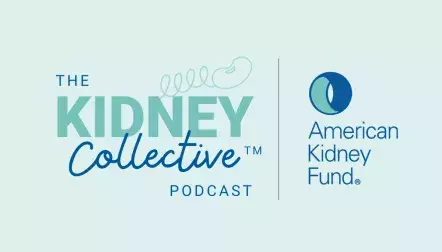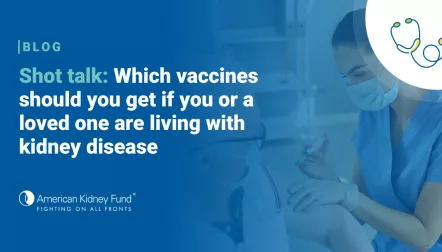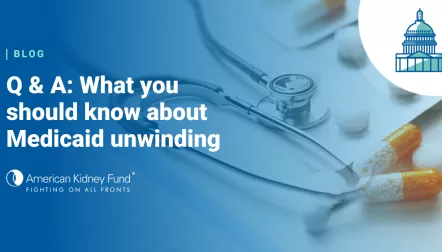
Blog post
Health insurance options during the COVID-19 pandemic

The COVID-19 pandemic has left tens of millions of Americans with reduced working hours, salary cuts or without jobs altogether, meaning they may no longer qualify for their employers' health insurance benefit or cannot afford to pay out of pocket for coverage and care. Since many Americans rely on their employers for health insurance, more and more people are now likely in need of non-employer-sponsored insurance, such as Medicaid and individual qualified health plans (QHPs) purchased through the Marketplace/Exchanges.
The American Kidney Fund (AKF) advocates for fully funding Medicaid and increasing the Federal Medical Assistance Percentages (FMAP) — the federal portion of Medicaid funding — during this public health emergency and national economic downturn. Enhancing federal financing for Medicaid will protect health care access for millions of Americans, especially during a time when it is needed most. QHPs available through the Marketplace/Exchanges, however, will be the option that most people with chronic illnesses, like kidney disease, will choose, particularly if their income was too high before the pandemic to qualify for Medicaid. It is essential that QHPs are affordable during the pandemic.
For people living with kidney failure, insurance options during this crisis are especially important. Even though the vast majority of dialysis patients are eligible for Medicare regardless of their age, Medicare coverage is not complete coverage. Medicare Part B pays only 80% of the fees for medical services, while patients are required to pay the other 20% — an amount that is prohibitive for kidney failure patients without supplemental insurance to fill that gap.
Under the Medicare Secondary Payer rule, an individual with kidney failure can continue on their private insurance as their primary coverage for 30 months after beginning dialysis. After that, Medicare becomes their primary insurance. Individuals who currently have a QHP and kidney disease (not yet in kidney failure) should look at all insurance options so they are prepared to make the best choice for their needs if they eventually require dialysis.
Health insurers who sell policies on the Marketplace/Exchanges are now filing their rates for 2021, and an initial review shows that rates should go down. One reason for this reduction is the medical loss ratio (MLR), or the amount of premium dollars collected by insurers that is spent on claims or quality improvement. People visited their doctors less during the first three months of the pandemic, and elective procedures were largely postponed, resulting in fewer insurance claims. QHPs must have an MLR of at least 80%, or their enrollees are entitled to a rebate for the difference. This year, QHP MLR fell below 70%, so insurers are now providing premium credits. Regulators should take insurers' profits from 2020 into account when they review the rate filings.
Insurers now have concerns that their enrollees will begin using services they postponed. As the pandemic drags on, people cannot continue pushing off medical care, including preventive care and elective surgeries. Elective surgeries can be reliably predicted based on pre-pandemic numbers; however, the potential costs of millions of people not getting preventive care are serious.
Patient advocacy groups like AKF and providers are concerned about people forgoing cancer screenings, kidney function screenings and yearly physicals due to fear of being infected with COVID-19 at the doctor's office. Delaying these services could result in patient care being more expensive because of the advanced state of the medical condition when first detected.
Another factor that insurance companies will consider when determining their rates is the likelihood of a larger risk pool.
QHP enrollment has declined slightly due to shorter enrollment periods, reduced marketing and a cut in the navigator program (paid staff who help the public with health insurance options). When the Trump administration eliminated the Affordable Care Act's (ACA) individual mandate requiring all Americans to have health insurance, healthier individuals could choose not to sign up for health insurance without facing a financial penalty. People are less likely to choose to go without insurance now because of the need for health care during a pandemic and the likelihood that they would be eligible for advanced premium tax credits to pay for all or part of their premiums.
The creation of short-term limited duration plans (short-term plans) also fragmented the insurance market, and there has been confusion about what these plans cover. Many people who enrolled in short-term plans believed they would have the same coverage that the ACA requires of QHPs, including coverage for pre-existing conditions, annual out-of-pocket maximums or no lifetime limits on coverage. Some people with short-term plans who contracted COVID-19 found their coverage during a health crisis is not adequate.
Multiple factors — people losing their employer-sponsored health insurance, the 5 million Americans (and counting) who have contracted COVID-19, and more Americans becoming eligible for premium tax credits due to their loss of income — may indeed result in higher QHP enrollment. These factors should shape a reduced cost for insurers for 2020, and the insurance rates should then be reduced for 2021.
As insurance companies continue to file their rates for 2021, Congress and state lawmakers should take steps to assist Americans who are out of work or who are very ill by ensuring health insurance rates are affordable.



